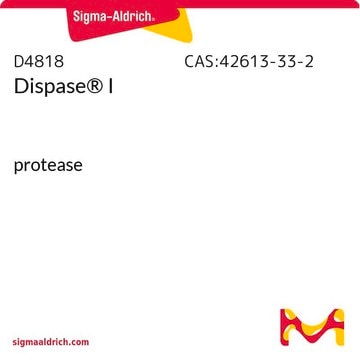LIBDL-RO
Roche
Liberase™ DL Research Grade
low Dispase concentration
About This Item
Prodotti consigliati
Forma fisica
lyophilized
Confezionamento
pkg of 100 mg (05466202001 [2 x 50 mg])
pkg of 10 mg (05401160001 [2 x 5 mg])
Produttore/marchio commerciale
Roche
Parametri
35-37 °C optimum reaction temp.
pH ottimale
7.4
Condizioni di spedizione
dry ice
Temperatura di conservazione
−20°C
Descrizione generale
Applicazioni
Caratteristiche e vantaggi
- Maximize viability and yield of isolated cells with an enzyme blend that has less clostripain and trypsin activity, as well as reduced endotoxin content.
- Count on higher specific activity of the enzyme blend as a result of higher Collagenase I + II purity (determined by HPLC analysis).
- Obtain higher experimental reproducibility due to higher lot-to-lot consistency.
Nota sulla preparazione
Working concentration: Liberase Research Grade Enzyme Working Concentration
Liberase enzymes have significantly higher specific activities than traditional collagenases. This means that the working concentration of Liberase Research Grade Purified Enzymes, expressed in mg/ml, will be lower than that of traditional collagenase.
When the application is on the Roche list of applications at www.collagenase.com, use the Liberase Research Grade concentration recommended for that application.
When the application is not included on this list, first use Liberase TM Research Grade at a concentration of 0.08–0.28 Wünsch units/ml.
The goal is to determine the best starting concentration of Liberase Research Grade Enzyme Blends. This is a starting point, and the final concentration may vary due to differences in procedure and lot-to-lot differences in traditional collagenase.
Collagenase Working Concentration
Multiply your previous collagenase working concentration (mg/ml) by its specific activity (Wünsch units/mg, [as determined above]), to obtain Wünsch units/ml. To determine how much Liberase Research Grade Enzyme Blend to use, first multiply your collagenase working concentration (in Wünsch units/ml) times the total volume of your working enzyme solution to obtain the total collagenase activity needed (Wünsch units). Divide the total collagenase activity required by the Liberase Research Grade stock concentration ( “Reconstitution and Storage”). This indicates how many milliliters of Liberase Research Grade Enzyme Blend stock solution to use in your working enzyme solution.
Storage conditions (working solution): Store unused stock solution in single-use aliquots at -15 to -25 °C. For further information on product stability, please visit the Roche Liberase Enzyme website at www.collagenase.com.
Note: Avoid repeated freezing and thawing!
Ricostituzione
Reconstitute the entire vial. Do not weigh individual aliquots of the lyophilizate. The introduction of moisture into the vial results in a decline in enzymatic activity.
Place vial on ice to rehydrate the lyophilized enzyme.
Gently agitate the vial at 2 to 8 °C until enzyme is completely dissolved (max. 30 min).
Depending on the type of tissue-dissociation buffer used to dissolve Liberase Research Grade Purified Enzyme Blends, slight precipitations may be observed readily dissolve in the diluted working solution and have no influence on enzyme activity.
Remove an aliquot of the stock solution to prepare the working solution.
Reconstitution volume
2 ml (1 vial with 5 mg–10 mg pack size)
10 ml (1 vial with 50 mg–100 mg pack size)
Collagenase Wünsch (units/ml)
13 (1 vial with 5 mg–10 mg pack size)
26 (1 vial with 50 mg–100 mg pack size)
Total Collagenase concentration [mg/ml]
2.5 (1 vial with 5 mg–10 mg pack size)
5.0 (1 vial with 50 mg–100 mg pack size)
Altre note
Note legali
Avvertenze
Danger
Indicazioni di pericolo
Consigli di prudenza
Classi di pericolo
Eye Irrit. 2 - Resp. Sens. 1 - Skin Irrit. 2 - STOT SE 3
Organi bersaglio
Respiratory system
Codice della classe di stoccaggio
11 - Combustible Solids
Classe di pericolosità dell'acqua (WGK)
WGK 1
Punto d’infiammabilità (°C)
does not flash
Certificati d'analisi (COA)
Cerca il Certificati d'analisi (COA) digitando il numero di lotto/batch corrispondente. I numeri di lotto o di batch sono stampati sull'etichetta dei prodotti dopo la parola ‘Lotto’ o ‘Batch’.
Possiedi già questo prodotto?
I documenti relativi ai prodotti acquistati recentemente sono disponibili nell’Archivio dei documenti.
I clienti hanno visto anche
Protocolli
Your current tissue dissociation protocol, and the extent to which you have been successful with traditional collagenase are good guides for selecting the appropriate Liberase Enzyme Blend.
Contenuto correlato
Collagenase Guide.Collagenases, enzymes that break down the native collagen that holds animal tissues together, are made by a variety of microorganisms and by many different animal cells.
Il team dei nostri ricercatori vanta grande esperienza in tutte le aree della ricerca quali Life Science, scienza dei materiali, sintesi chimica, cromatografia, discipline analitiche, ecc..
Contatta l'Assistenza Tecnica.

















